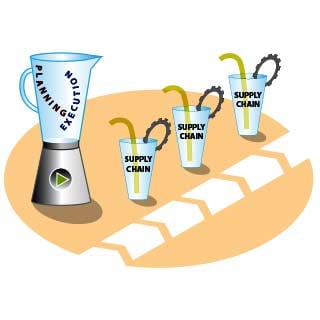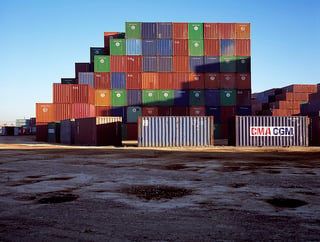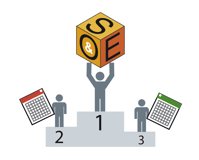On Merging Planning and Execution in the Supply Chain
Nick Ostdick - May 12, 2016

 Twenty years ago when planning a road trip you had to chart your route beforehand on an actual map. You plotted your destination based on best guesses for speed and convenience without any knowledge of road conditions, problematic traffic patterns, or other hazards, making it nearly impossible to incorporate adjustments should travel disruptions occur.
Twenty years ago when planning a road trip you had to chart your route beforehand on an actual map. You plotted your destination based on best guesses for speed and convenience without any knowledge of road conditions, problematic traffic patterns, or other hazards, making it nearly impossible to incorporate adjustments should travel disruptions occur.
Fast forward years and the internet with applications like Google Maps made creating a route a more interactive, streamlined process with greater insight and visibility into your planned route, including construction, detours, delays, and other travel complications, and even offering alternate routes to your desire destination. Jump into present day and you have GPS capability - much of which is mobile-enabled - where you can input a destination and receive in real-time the most expedite route for arrival, current road conditions, alternate routes, estimated arrival times, and more, all of which can be altered in the moment to suit your current needs and demands.
This level of agility has all but eliminated the complications involved with planning your route prior to executing it, and much the same can be said for the merge of planning and execution in today’s global supply management strategy. Gone are the days of the cumbersome, impossible-to-fold map, just the same as the days when demand planning and execution were two distinct processes.
Planning and Execution - A Survey of Today’s Strategy
In the last decade or so, huge advancements in optimized supply chain operations - PFEP strategy, order slotting, sequencing, BOM explosion - have fueled a shift to more dynamic, interactive supply chain practices where planners and managers have greater control and visibility across a company’s entire supply stream. But many companies still engage in operations and demand planning as one stage of the supply process, then view execution as a crapshoot of this planning with little oversight into efficiency, allocation of resources, and cost-effectiveness.
 This also creates silos at each point in supply chain execution - order fulfillment, warehousing, and transportation - which results in very little monitoring of results, and measurements of performance are often completed far too late to have any real impact on a company’s supply network.
This also creates silos at each point in supply chain execution - order fulfillment, warehousing, and transportation - which results in very little monitoring of results, and measurements of performance are often completed far too late to have any real impact on a company’s supply network.
The consequences of this are reduced visibility and transparency, which can severely hamper a company’s ability to be agile and maneuver the complexities of today’s global supply chain management - for example, a company with facilities across the world can run into severe roadblocks in terms of coordination and communication by operating planning and execution in a vacuum. And this latency between planning and execution can also create a whole new set of complexities for companies weighing centralized or decentralized planning strategies - something we’ll touch on momentarily.
Planning and Execution - A Reevaluation
Let’s go back to our road trip for a moment. You’re on the interstate and run into a severe traffic back-up due to unforeseen construction. You input this data into your GPS, which then creates an alternate route to save you time and money. This strategy, which is what we’ll call continuous planning, is how companies must view the intersection between planning and execution, and while this is obviously dependent on implementing the right software solutions with real-time reporting and adjustment capabilities, a fundamental shift in planning and execution philosophy is also required to embrace this new method of thinking.
 Many companies currently address latency between planning and execution with re-planning or other strategies that require constant intervention - which is essentially the same as pulling over to the side of the road and consulting a map each time you encounter a disruption. Continuous planning, however, with assistance from networked systems, cloud-computing, and in-memory technologies is the only way to drive value and increase supply chain efficiency, especially in a more diverse, variant-rich supply stream with production and warehousing on a global scale.
Many companies currently address latency between planning and execution with re-planning or other strategies that require constant intervention - which is essentially the same as pulling over to the side of the road and consulting a map each time you encounter a disruption. Continuous planning, however, with assistance from networked systems, cloud-computing, and in-memory technologies is the only way to drive value and increase supply chain efficiency, especially in a more diverse, variant-rich supply stream with production and warehousing on a global scale.
Another factor to consider when merging planning and execution is the relationship between centralized and decentralized planning. Centralized planning, with a singular hub for all facilities to report, lacks the visibility and transparency we’ve discussed because facilities don’t have access or insight into how each one functions and the reporting thereof. On the other hand, a decentralized planning system operates each facility as a self-contained unit, and while there may be communication between these units, planning and execution across all units can be difficult because reporting and analysis is not filtered into one centralized location.
Where merging planning and execution into a continuing planning strategy comes into play is creating a bridge between these two systems of planning whereby each facility not only reports to a centralized location, but can also access key data that is crucial to driving production efficiency where delivery is met on-time in the specified quantities and conditions.
Planning and Execution - The Future
Given how far demand planning and execution have come during the last 10 to 15 years, it’s difficult to see where these concepts will go in the next 10 years, except to say the sky is the limit. Continuing advancements in technology and the proliferation of continuous planning strategy will significantly impact an industry that is becoming ever-more connected and diverse as new markets emerge and establish themselves. And companies who successfully reengineer their strategies to view planning and execution as a single action will be well-positioned to gain a competitive advantage in a very competitive industry.
LATEST POSTS
- Understand Why Production Planning Needs Specialized Solutions
- Understand Circular Economy in The Manufacturing Industry
- How Can Industry 4.0 IT Integration Be Achieved Smoothly?
- The Significance of Order Sequencing in Discrete Manufacturing
- How to improve your Supply Chain Management: The Power of Control Towers



